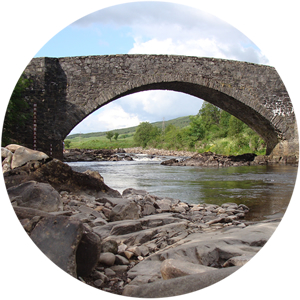
Thousands of bridges in the UK span streams and rivers. During floods they can be scoured by the flow and even collapse. Identifying bridges at risk allows us to target protection where it’s needed most.
Click here for coverage of the Bell and Pooley Bridge collapses in Cumbria during the December 2015 floods.
Identifying structures at risk
Guidance on how to assess the risk of scour at bridges according to a tiered Level 1 and Level 2 system of analysis is provided in:
BD 97/12 The assessment of scour and other hydraulic actions at highway structures
in the Design Manual for Roads and Bridges.
This identifies the hydraulic and hydrological characteristics of a bridge and any shortcomings in known data about the depths and materials of its foundations. The analysis results in a risk level, which in turn guides priorities for bridge maintenance.
WHS has developed an efficient process for undertaking Level 2 scour assessments. We have undertaken assessments for several councils and highway authorities and we are pleased to have been awarded a recent commission to assess 15 bridge structures in the East Midlands for Highways England.
Assessment limitations
Although BD 97/12 provides a robust framework in which to assess the risk of scour in structures, and to determine maintenance priorities, the analytical techniques it uses do have limitations.
For example, a key assumption is that an equilibrium in scour depth is reached at a constant extreme flood flow, which leads to very high theoretical scour depths. In reality, these scour depths will never be achieved as extreme flood flow will not remain at its peak long enough to achieve the full scour depth.
Understanding scour
The physical processes of scour are complex, with many uncertainties such as:
- detailed 3D hydrodynamics and vortices, leading to large variations in local velocities
- the performance of structure foundations and uncertainty on foundation depths
- variations in river-bed geomorphology in planform and depth below river-bed level.
Although site investigations can provide more detailed information on these variables, significant uncertainty in structure and river-bed material performance may remain.
Because of this, determining an ‘absolute’ value of scour depth on a structure is perhaps not the key objective. Instead it is more useful to understand how scour may be affected by different assumptions and variables.
The last word
Increasing computer power means that 3D modelling of scour is increasingly viable.
This enables sensitivity testing; capturing local variations in velocity and material properties, and capturing the hydrodynamic rise and fall of extreme flood events.
At critical bridge structures, where significant scour-protection works may be required, such analysis may be justified, to understand structural performance under different conditions more fully.

Example of 3D modelling of bridge scour using Flow 3D software
Image courtesy Flow 3D and Flow Science Inc